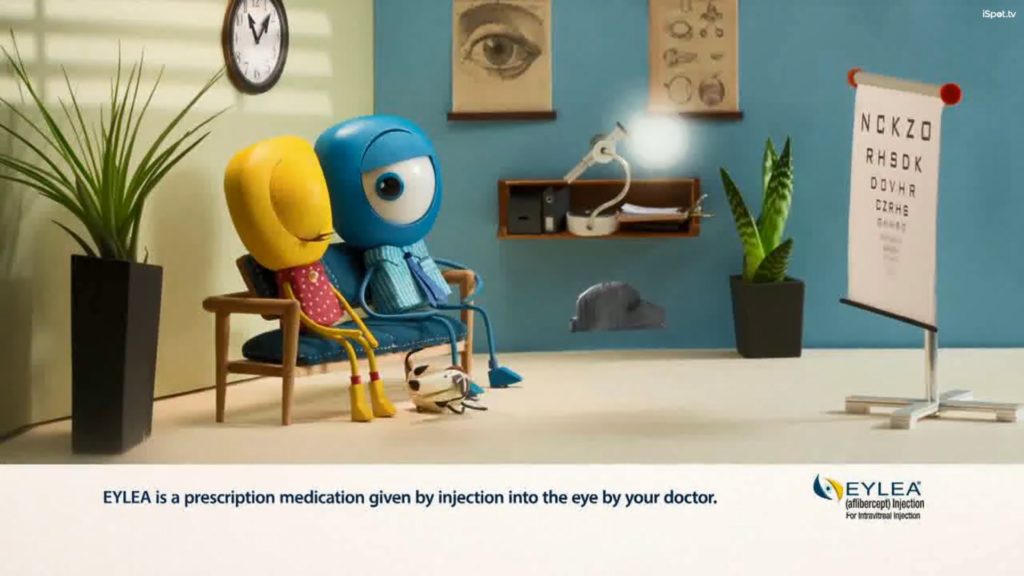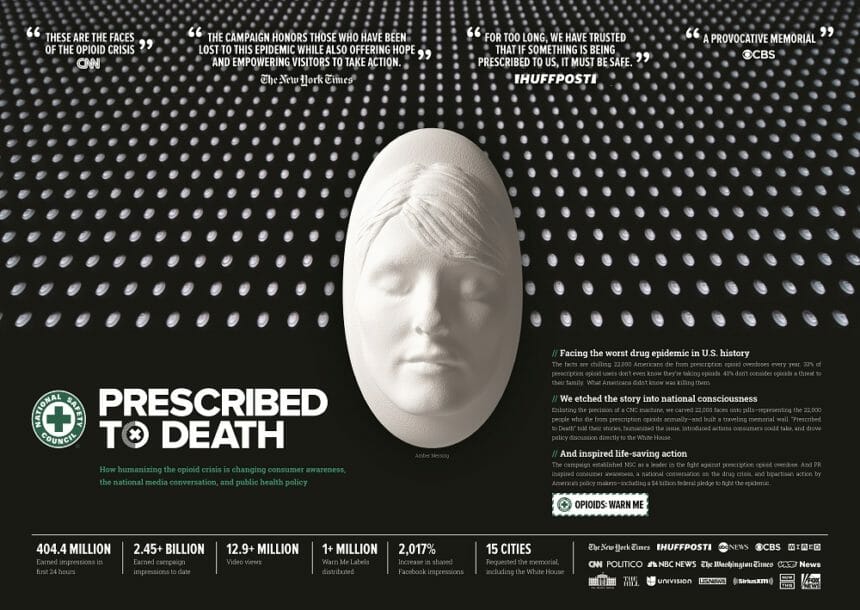Asked for her biggest-picture take on the past year or so in DTC advertising, Ogilvy Health’s chief creative officer Samantha Dolin addresses what has emerged as one of the industry’s biggest frustrations with consumer efforts: The focus on 60-second TV spots at the expense of everything else.
“When I think of DTC nowadays, I think of something much broader than TV,” she says. “The way we define it is evolving, from just TV and print to creating meaningful connections and interactions in this emerging omnichannel universe. Many brands are moving into a more experiential space, which happened outside our category a couple of years ago.”
Dolin also notes how what she calls “the less traditional categories” have started to invest more heavily in consumer-facing marketing.
“You’re seeing big consumer plays in the oncology space, which has traditionally fallen squarely in the professional [marketing] domain,” she explains, pointing to Merck’s “beautiful” Keytruda spots as a prime example.
“That suggests companies have finally started to acknowledge consumers are far more invested in health conversations and dialogues.”
Here are Dolin’s rankings for the year’s 10 best DTC campaigns:
1. National Safety Council: Prescribed to Death
I wanted to look for things that were “un-pharma,” campaigns that tell a story, connect to clear insights, and tap an unmet need. This one hits on all cylinders.
There’s so much conversation about the opioid crisis and almost everyone is affected by it in some shape or form, yet there’s still this idea that opioid overdoses happen to addicts in dark alleys. The reality is, this is very much an everyday epidemic — it hits moms, dads, neighbors, co-workers, and teachers. These are your average people who live next door.
The campaign is so poignant. It celebrates the lives and humanity of these people, telling their stories in three-dimensionally rendered portraits and put together in a way that makes you feel the magnitude of those trapped inside their addiction. It hits home in a visceral way.
2. National Organization for Victim Assistance: The Rape Tax
Conversations around rape and sexual violence have finally come to the forefront of our discourse, and it’s good to have that level of awareness. But the discussion generally stops there. We don’t talk about what happens to victims after the fact.
Not only have they endured this horrible, violent situation, but the impact on their lives will also continue long after the incident itself. They get “taxed” by hospitals and doctors when they’re trying to get their health restored, which is crazy.
The pull through on this campaign is fantastic. It lets victims share their personal stories and actually generate a bill that quantifies the impact of their assault, which can be shared to highlight the issue more broadly. It’s an incredible dialogue starter.
3. NewYork-Presbyterian Hospital: Amazing Things are Happening Here
This campaign has been going on for awhile, but the most recent executions get into a bigger, newer area in terms of what a hospital can do from a service perspective. These head-on, personal vignettes feel very intimate. Stylistically they may not be anything revolutionary, but the stories are so poignant. That’s what makes this special.
In our space, it’s difficult to get real stories from non-actors to come across in an authentic way and to create that level of continuity we strive for as storytellers. This campaign does it in every single one.
There are also a number of pull-through applications that lean into this notion of “amazing things.” The Txt 2 Hlp campaign trains terminally ill cancer patients from NewYork-Presbyterian to become suicide counselors. It’s putting people who have had to confront their own mortality in touch with other people who are struggling with “what does life mean to me now?” The dialogues that have ensued are so rich.
4. PhRMA: GoBoldly
So much of the discourse around the pharma industry is negative. And in some instances, such as the Epi-Pen pricing scandal, the backlash is warranted. That’s why this campaign, which brings back humanity to the industry by highlighting the people who are advancing the science, is so elegant and vibrant. It illustrates the heart and soul these researchers are putting into their work and the reasons why. And it’s lovely across channels: The print execution (above), where you have the researcher on one side and the patient on the other, offers a beautiful juxtaposition.
What’s unusual about this campaign is it’s not self-serving. This feels like a much bigger, aspirational, and even altruistic way to connect with a broader audience. It doesn’t feel defensive and it would’ve been very easy for an industry campaign such as this to come off as such, especially given the anti-pharma feeling that’s out there.
5. Hims: Baldness/ED is Now Optional
This is another one that, from a sheer creative perspective, feels so un-pharma. It does a brilliant job of connecting with men, which is a tough audience to engage in health conversations. Traditionally, whenever there’s a product for men, we always end up including women in the conversation. Men are very challenging to activate because they might not want to talk about things that question their strength or masculinity — especially not issues that are at the heart of their manhood.
This is straight-shooting and uses direct, conversational language. It gives the audience permission to start talking about these conditions, which historically have been ones that everyone wants to sweep under the rug. Even the way Hims handles important safety information, a huge topic in our industry, is different. It’s on-label, but it’s accessible and conversational in nature.
6. Roman: GetRoman
This is similar to the Hims work and represents an interesting turn in our industry. In the past, we’ve mostly just marketed the product itself. Here, we’re talking about a product/service combination and making sure the experience is easy to discuss.
When you can do full 360-degree marketing in pharma — not just getting the eyeballs on the product, but also following through from an experience perspective — that’s very Virgin Airlines to me. The broader industry should take this to heart.
I was at other agencies during the early days of Viagra and Cialis, when everybody was starting to reckon with the taboo of desexualizing conditions such as erectile dysfunction. Now you have campaigns such as this, where there is an invitation for dialogue, but in a smart, fun way. There are no hugs, pats on the back, or mushy stuff. It treats ED like any other issue — let’s deal with it and move on with life.
7. CoolSculpting: Not Cool vs. Cool
In the past few years there’s been a ton of new marketing for cosmetic pharmaceuticals and aesthetic procedures. So much of it is beauty and glamour shots, as you’d expect. But we’ve also seen a number of cheaper, impostor procedures and ridiculous gimmicks flood the space. As a result, it’s become a category that’s congested, with results that end up being elusive to the everyday patient. In a sense, that negates or delegitimizes other products out there.
What CoolSculpting does (below) that’s smart is address it head on: “Is this another fad? Will this work?” This campaign takes a shot at the ridiculous fads in the market and reinforces the role CoolSculpting can have because the results are real and powerful. We move from far-fetched scam to something that truly works. And we move from the often unattainable beauty shot we’d see in Vogue or Cosmopolitan to something that’s accessible and everyone can achieve. These spots keep your attention, and to do so in this day and age is noteworthy.

8. Xiidra: Niice Eyes
The unbranded Eyelove work with Jennifer Aniston has gotten a lot of attention, but the animation and storytelling in this branded effort is so unexpected. It’s novel and fresh and, by telling the story visually, it makes you want to watch more of it. It’s great eye candy in a campaign about eyes — brilliant.
Xiidra has also done a beautiful job with the reminder branding. So many of these products are impossible to pronounce, which means you’ll never remember them. It leaned into this with “Xiidra: I want the one with the two Is.” Plus it’s constantly putting out fresh, engaging, well-designed, shareable, and snackable content via social media.

9. Eylea: A Beautiful Pair
The stories are executed so beautifully, both visually as well as from an editorial and storytelling perspective. The brand has done something so hard in this type of work, which is create characters that are adorable, likable, and also a little quirky (above). You want to follow along and see where the story goes.
Also, rather than creating unique campaigns for each indication, it has adapted the branding and storytelling to meet the different needs. Similar to Xiidra, Eylea did it without the usual lifestyle images — people walking on the beach, that kind of stuff — and instead created an experience to delight the eyes.
10. Xeomin: Smash Through Labels
It’s rare you can say something like this, but the print ad has real stopping power. Also, the platform behind this is brilliant and plays off the shaming of women who get fillers, Botox, or any aesthetic procedure. Think about it — you get judged if you have wrinkles or belly fat, but now there’s a culture where you get judged if you want to do something about it.
It leans into the “later, haters” theme by playing up that sense of empowerment in owning what’s good for you and what makes you feel good as a person, not out of vanity, but out of strength. That’s a powerful statement to make. I always look for brands that have a higher-order position and Xeomin has done a great job telegraphing that idea. Why can’t you be smart, powerful, and beautiful?
From the April 01, 2019 Issue of MM+M - Medical Marketing and Media







